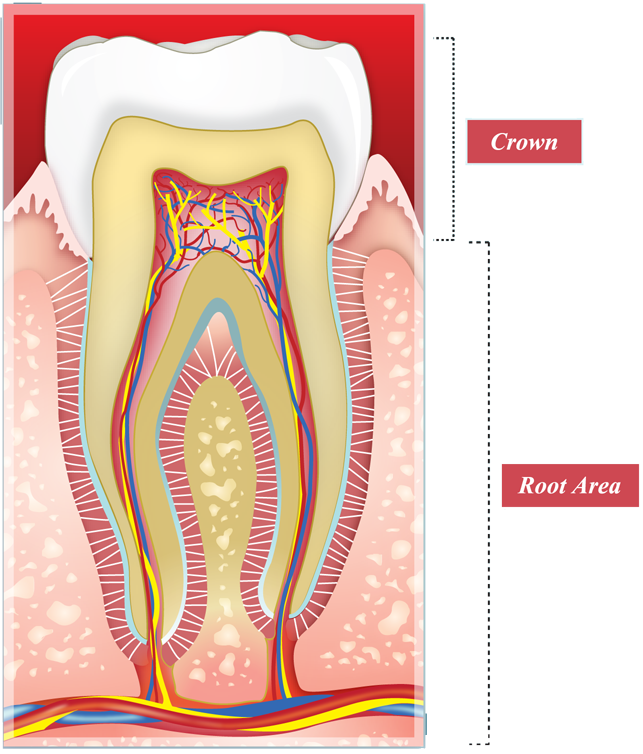Introduction
The aim and objective of endodontic and restorative dentistry is the conservation of natural tooth structure.
Root (endodontic) treated tooth undergo loss of tooth structure and changes in physical characteristics, such as a reduced modulus of elasticity, which often lead to increased fracture susceptibility when compared to unrestored vital tooth. Often, discoloration and decreased opacity are aesthetic changes that accompany the above. It is the aim of the dental practitioner to correct these changes when restoring endodontically treated tooth.
Endodontically treated tooth frequently required indirect restorations because extensive loss of healthy tooth structure as a result of carious lesion, fracture and preparation during endodontic treatment.
Factors influencing the prognosis of endodontically treated tooth:-
Coronal seal
The final component of endodontic reconstruction is the coronal restoration. Coronal restoration will re-establish function, isolate the dentin and endodontic filling materials from microleakage will provide coronal seal. A well-sealed coronal restoration is therefore critical to endodontic success. Once root-canal treatment is completed, immediate restoration of the tooth is recommended whenever possible.
Type of restoration
Cuspal coverage restorations will provide higher longevity to posterior teeth with root canal treatment.Bonded restorations represent the main choice for conservatively restoring anterior teeth with minimal loss of tooth structure.
Type of coronal restorations:-
- onlay- metal, ceramic (fig. 1)
- crown- metal, ceramic and combination (fig. 2 & fig. 3)
- composite restoration
 |
 |
| Fig. 1 : Onlay- ceramic | |
 |
 |
| Fig. 2 : Metal crown | Fig. 3 : Ceramic crown |
Filling
In anterior teeth with minimal loss of tooth structure, the coronal seal can be achieved by composite filling material only and no indication for cuspal coverage.
Post and Core
When a tooth has more than 50% of its coronal structure missing, the use of a post-and core foundation is recommended prior to prosthetic restoration. A post is a dental material placed in the root of a structurally when additional retention is needed to retain the core and coronal restoration. The main purpose of a post is to retain the core build-up in a tooth with extensive loss of coronal tooth structure. The post should provide this support without increasing the risk of root fracture. The post itself does not strengthen or reinforce the tooth; the inherent strength of the tooth and its resistance to fracture comes from the remaining tooth structure and the surrounding alveolar bone.
Types of post and core material
There are two main categories of posts: custom-fabricated and prefabricated.
Custom-fabricated cast gold post (fig. 4) and core has been used for decades as a foundation restoration to support the final restoration in endodontically treated tooth. Currently prefabricated post was introduced and made from stainless steel, titanium (fig. 5) and titanium alloys, goldplated brass, ceramic and fiber-reinforced polymers. The most commonly used core materials are cast gold, amalgam, resin-based composite and glass ionomer cement. Fiber-reinforced posts (fig. 6) are fabricated to bond with most resin cements and resin-based composite core materials.
 |
|
| Fig. 4 : Custom fabricated cast post | |
 |
 |
| Fig. 5 : Titanium prefabricated post | Fig. 6 : prefabricated fiber post |
Procedure for placement of post and core
After the endodontic procedure has been completed, and the root canal(s) is/are filled with the gutta percha root canal filling material (fig.7). Some of gutta percha is removed from the canal space to create the post space. It is desirable to leave sufficient root filling material (3-6mm) in the apical area to maintain the apical seal. The prefabricated post is cemented into the post space, a core material, such as composite can be packed around the cemented post. After the material has been cured or has had a chance to set and properly formed into a crown preparation, an impression can be taken for the fabrication of a prosthetic crown

Fig. 7 : Gutta-percha root canal filling
Complications
Root perforation
Complications during post space preparation are root perforation and root fracture. Root perforation also can be caused by endodontic instrument that accidentally perforates the root. A missed curve in a root canal may result in the endodontic file penetrating the side of the tooth.
Root fracture
Vertical root fractures can occur during different phases of root canal treatment (fig. 8): instrumentation, obturation or during post placement. If the post is forced apically during seating or cementation, the risk of fracture is high, particularly if the post is tapered.

Fig. 8 : Root fracture
Post fracture and split
The post fracture happened in failed root canal cases, usually the crown , core and post will fracture / split due to mechanical and biological failure.
References
- Vytaute Peciuliene, Jurate Rimkuviene: Vertical Root Fractures in Endodontically Treated Teeth: A Clinical Survey. Stomatologija, Baltic Dental and Maxillofacial Journal, 6:77-80, 2004
- Constantin Vârlan et al: Current opinions concerning the restoration of endodontically treated teeth: basic principles. Journal of Medicine and Life Vol. 2, No.2, April-June 2009, pp.165-172
- Alex McLean: Predictably Restoring Endodontically Treated Teeth. Canadian Dental Association December 1998 Vol. 64 No. 11
- William Cheung: A review of the management of endodontically treated teeth.Post, core and the final restoration. JADA, Vol. 136
- Endodontic Colleagues of Excellent The Endodontist’s Perspective, Part 1. Spring/Summer 2004
- Jeff Chadwick et al: Restoration of Endodontically Treated Teeth: An Evidence-Based Literature Review. University of Toronto, Community Dentistry 300Y March 20, 2008
- Cohen and Burns. Pathway of the pulp. 8th Edition. Mosby 2002
| Last Reviewed | : | 23 August 2019 |
| Writer | : | Dr. Aniza bt. Ahmad |
| Accreditor | : | Dr. Saripah bt. Saud |
| Reviewer | : | Dr. Roshima bt. Mohd Sharif |








